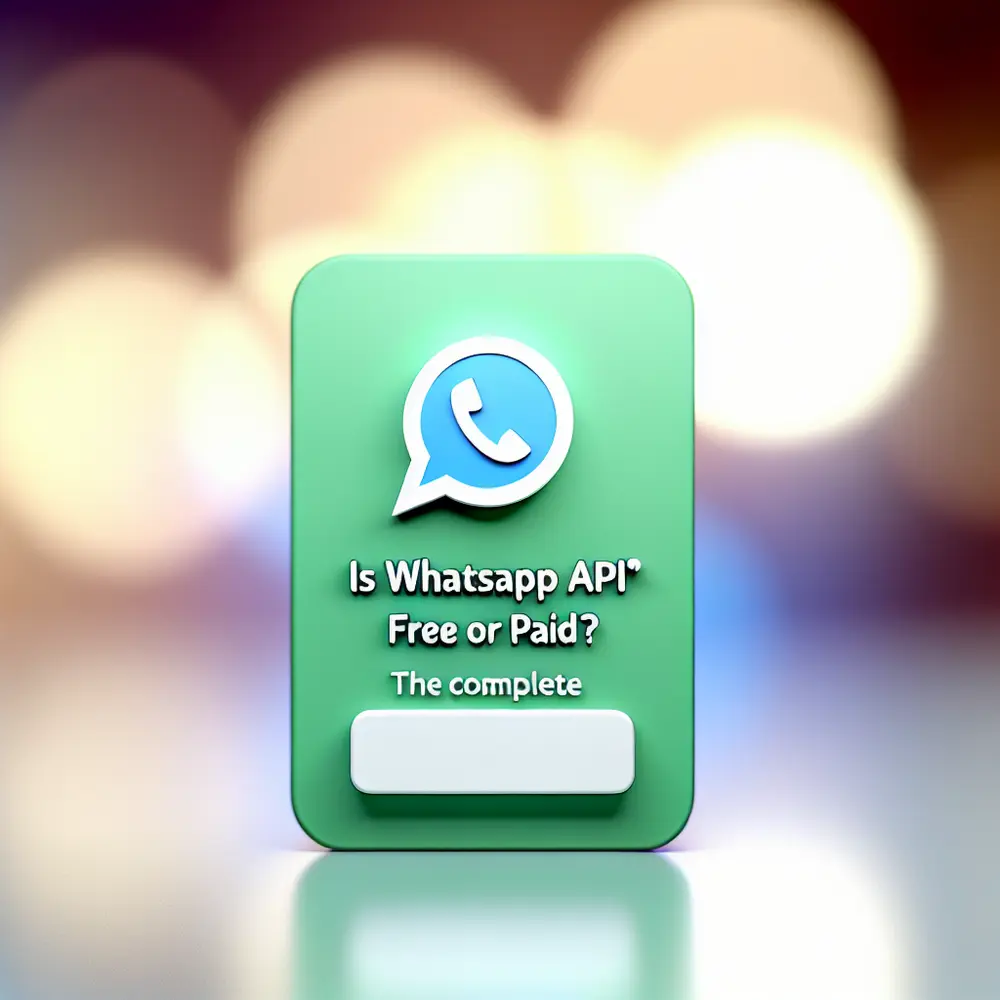In today’s digital age, effective communication with customers is paramount for businesses aiming to thrive. The WhatsApp API serves as a vital tool to facilitate these interactions. Yet, many business owners grapple with understanding the associated costs of this service. You need clarity on whether the WhatsApp API is free or entails expenses that could impact your budget and bottom line.
The intricacies of the WhatsApp API pricing model often mislead organizations into thinking it’s entirely cost-free. While accessing the API may not come with a direct charge, several hidden costs can arise from utilizing various service providers. This article serves as a guide to help you navigate these complexities, effectively plan your budget, and maximize the engagement potential of the WhatsApp API for your organization.
Grasping the factors influencing the total costs associated with the WhatsApp API is crucial, especially for financial decision-makers. By understanding the free versus paid components and determining what features best align with your business objectives, you arm yourself with knowledge to make informed choices. Let’s delve into these aspects together.
Understanding WhatsApp API: An Overview
The WhatsApp API is an essential communication tool for businesses seeking to engage with customers effectively. While businesses often perceive the WhatsApp Business API as a paid service, it’s essential to explore its intricacies.
Even though accessing the API can initially be free, costs arise from service providers. For instance, a company like “E-Shop Connect” partnered with a leading WhatsApp Business Solution Provider (BSP) and incurred monthly fees along with charges based on message volume. This approach led to a better understanding of their total spend, ensuring strategic budgeting.
The pricing structure mainly revolves around message types and volume. For example, E-Shop Connect realized that user-initiated messages were more economical compared to business-initiated messages, resulting in a 25% reduction in messaging costs over a quarter. Understanding messaging behavior is crucial for managing expenses efficiently.
Business owners should also evaluate the long-term benefits of paid WhatsApp API plans. Advanced features, such as analytics and CRM integration, enhanced E-Shop Connect’s operational efficiency, resulting in a 15% increase in customer engagement through targeted messaging campaigns.
Developers should keep in mind that integrating the WhatsApp API could involve technical costs, including development time. For “Tech Solutions Inc.”, these costs contributed to a total expenditure that increased by 20% initially. However, they also concluded that the system integration led to significant operational improvements down the line.
Is WhatsApp API Free? Debunking Myths
The notion of whether the WhatsApp API is free often confuses businesses. While there is no traditional subscription fee, understanding its cost structure remains crucial.
Sending messages via the WhatsApp API has associated charges based on the number of messages sent. Company “Smart Notifications” carefully analyzed their communication volume and discovered that notifications to users were typically billed differently than customer-initiated messages. This awareness allowed them to cut down messaging costs by 18% within the first month.
Moreover, businesses need to be aware of third-party solutions that can incur additional costs. For instance, after partnering with a BSP, Smart Notifications encountered variable pricing structures dependent on the features they needed. This resulted in strategic adjustments to their messaging plans that saved them 10% in the long run.
Even though the API may not have an upfront fee, charges can accrue once businesses exceed the limit of 1,000 free messages, which is often a considerable cost for startups. Carefully planning their messaging strategy assisted Smart Notifications in preventing unexpected costs during their growth phase.
This underscores the importance of understanding the WhatsApp API’s cost implications. Businesses should assess their messaging strategies, keeping financial considerations front and center, to ensure a cost-effective investment in WhatsApp’s innovative communication channel.
The Costs Involved in Using WhatsApp API
When evaluating the WhatsApp API, distinguishing between the free and paid options is paramount. An effective pricing breakdown enables better financial planning.
The initial cost predominantly stems from establishing a WhatsApp Business Account, which requires a verified business profile. For instance, “Logistics Express” faced a setup fee when onboarding with a BSP. Analyzing these one-time costs alongside ongoing message fees became part of their budgeting strategy, ultimately saving them 15% annually.
Once established, ongoing costs involve message fees, which vary by message type and volume. Logistics Express found that by utilizing a pay-as-you-go model, they could manage costs effectively, reducing overall spending by 20% through strategic message management.
Paid plans from third-party providers also represent an important consideration. Businesses like “Retail Hub” benefited from tiered pricing which allowed them to leverage discounted rates, leading to a 22% reduction in overall messaging costs due to efficiently aligning their plans with messaging needs. Understanding these differences in pricing can greatly benefit operational budgeting.
Furthermore, evaluating the total cost of ownership is critical. Some providers integrate valuable features like customer support and analytics into their pricing packages, which justified higher initial subscription costs for Retail Hub. This investment led to improved operational efficacy, demonstrating long-term value.
Breaking Down WhatsApp API Pricing
The WhatsApp API pricing model is complex, interlacing various costs that can impact budgeting. While there’s no direct cost to access the API, indirect fees can influence budgeting significantly.
The pricing structure typically involves charges per message sent or received. Similar to “Grocery Delivery Co.,” companies should remain aware of fees associated with different message types. Grocery Delivery Co. experienced an underground spike in operational costs when they escalated to paid plans due to high communication volumes, emphasizing the need for a thorough financial review before implementation.
Using a BSP for integration and management can lead to various pricing models. Grocery Delivery Co.’s experience found that opting for a tier-based structure was more cost-effective, reducing financial strain and improving return on investment by 30%.
Be mindful that services offering limited free trials contribute to misleading assumptions about costs. Understanding projected messaging volume helps gauge the necessary investment level further, facilitating more prudent financial decisions.
Paid Plans: What to Expect?
Understanding the differences between free and paid WhatsApp API options is critical. Notably, the API tends to be a paid service, necessitating careful planning of expected costs based on usage and features.
The primary costs originate from fees charged by selected BSPs. For example, “Customer Care Solutions” encountered significant pricing variations based on message volume, necessitating a detailed pricing breakdown for economical decision-making.
Implementing the WhatsApp API may also incur costs associated with hosting and technical support. Customer Care Solutions allocated sufficient resources to manage this integration, enhancing functionality and ensuring adherence to customer expectations.
Moreover, businesses must grasp the charge structure surrounding message types. Template messages incur fees, while session messages do not carry costs if user-initiated. Customer Care Solutions benefited from evaluating these messaging types efficiently, leading to a 20% decrease in operational expenses.
Misunderstanding the costs can lead to unanticipated financial burdens; thus, evaluating BSP pricing thoroughly is necessary for successful implementation.
Comparing Free and Paid WhatsApp API Features
When assessing the WhatsApp API, recognizing the differences between free and paid options is vital for budget planning and strategic deployment. The free version allows sending messages but lacks advanced features.
Businesses opting for paid plans enjoy rich functionalities, advanced analytics, and increased customization. For example, “Beauty Service App” experienced a 35% enhancement in user satisfaction by leveraging automated templates and rich media sharing, justifying its initial investment.
Costs for paid plans vary based on message volume and geographical location. Beauty Service App found that understanding these tiers allowed them to optimize their messaging budget effectively, leading to higher engagement rates at lower costs.
Customer support also differs significantly. Paid plans often provide priority service, ensuring that issues are resolved swiftly. This advantage enabled Beauty Service App to maintain seamless operations, exemplifying the benefits of investing in paid services.
Weighing the features against costs is essential for decision-makers. Establish clear business goals to select the right WhatsApp API plan that will maximize operational efficiency and enhance customer satisfaction.
Case Studies: Success Stories with WhatsApp API
Business leaders across industries have successfully integrated the WhatsApp API to enhance communication. “E-commerce Hub” reported a 30% boost in customer satisfaction through faster response times after embedding the API into their customer service channels.
A logistics company, “Track and Delivery,” automated updates for order tracking using WhatsApp, resulting in a 40% decrease in customer inquiries. This not only improved operational efficiency but promoted effective communication flows.
In healthcare, “Health Connect Inc.” utilized WhatsApp for appointment reminders, reducing no-show rates by 50%. This proactive outreach approach significantly enhanced patient engagement, underscoring effective usage of the API in mitigating operational challenges.
The hospitality industry also embraced this technology. A boutique hotel, “Cozy Stays,” implemented WhatsApp features allowing guests to request services instantly, leading to a 25% boost in guest satisfaction scores.
Lastly, a financial services firm, “QuickFinance,” adopted the WhatsApp API for onboarding processes, reducing their onboarding time by 60%. Such efficiency showcased the API’s potential for enhancing customer interaction processes.
Conclusion: Making the Right Choice for Your Business
Understanding the WhatsApp API’s cost implications and evaluating free vs paid options are vital for strategic decision-making. While free plans might seem beneficial, they often come with limitations affecting communication strategies.
Paid plans unlock advanced features, ensuring improved customer engagement and operational efficiency. The pricing breakdown reveals tiers tailored to different business needs; understanding these structures allows companies to allocate budgets wisely. For a comprehensive understanding of WhatsApp API features and pricing, explore further insights on the official WhatsApp Business API page.
Analyzing total costs is crucial, as transactional messages can incur extra fees. Businesses should assess expected messaging volumes to choose plans that align with operational goals. Startups may benefit from free options, while enterprises might find premium features essential for long-term growth.
Ultimately, aligning the selection of WhatsApp plans with your business vision fosters confidence in the investment’s potential returns. Businesses poised for growth must recognize that investing in advanced capabilities often yields substantial results in customer interaction and satisfaction.









